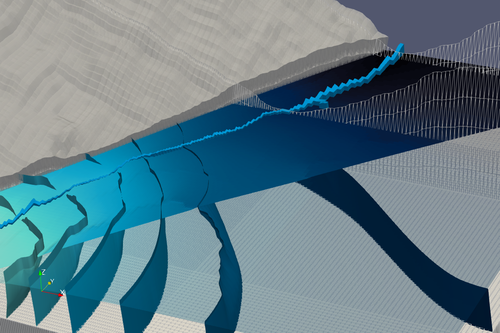Objectives
These are the course objectives:
- Build and calibrate groundwater flow models on mine closure areas
- Apply Flopy codes for representation of observed data of heads and water quality
- Evaluate the performance of remediation techniques in waste dumps
- Simulate impact of contaminant plumes in surface water bodies.
Course content
Session 1: Introduction to contaminant transport
- Building a simple groundwater flow model
- Coupling solute transport to MODFLOW with MT3D-USGS
- Analyzing results regarding flow and mass balances
- Visualization of the distributions of heads and concentration.
Session 2: Construction of the groundwater model
- Implementation of the model limits, boundary conditions, and aquifer properties with shapefiles
- Definition of zones with grid refinement near the source of pollution.
- Assignment of topography from Digital Elevation Models.
- Definition of Solver parameters and running the model.
Session 3: Calibration of steady-state groundwater flow
- Analyzing the flow balance with Flopy and Pandas for table manipulation.
- Plotting simulated vs. observed hydraulic heads in Python and ModelMuse
- Calculation of statistics related to the error in simulated heads.
- Visualization of the groundwater flows in 3D with ModelMuse and in 2D with Flopy.
Session 4: Construction of the transport model
- Analyzing the transport model packages to be implemented
- Configuration of the Advection and Dispersion packages
- Assignment of initial concentrations in the aquifer and delimiting the source of pollution.
- Configuring the source of pollution and analyzing the different ways to implement it.
- Defining the times of simulation before and after the closure of operations.
Session 5: Calibration of the transport model
- Analyzing the mass balance with Flopy and Pandas.
- Plotting the observed vs simulated concentrations before and after the closure of operations.
- Evaluate the different trends before and after the closure of operations.
- Develope plots in 2D and 3D of the distribution of the pollutant plume before and after closure of operations.
Session 6: Vtk rendering with Hataripy and ModelMuse
- 3D representation of the model properties and boundary conditions.
- Representation of the water table in 3D and equipotentials of the heads.
- Representation of the plume at closure, and after remediation
- Import of models developed in Flopy to ModelMuse and post-processing of results.
Methodology
Here are some details of each methodology:
- Manuals and files for the exercises will be delivered.
- The course will be developed by videos on private web platform.
- There is online support for questions regarding the exercises developed in the course.
- Digital certificate available at the end of the course.
- Video of the classes will be available for 2 months.
- To receive the digital certificate you must submit the exercises after 1 month.

- Teacher: Saul Montoya